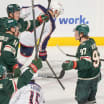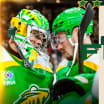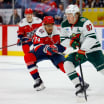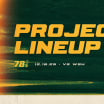The landscape of girls' hockey at all levels looks remarkably different from what it was 20 years ago. One key distinction?
"There's actually girls," said Natalie Darwitz, who won three Olympic medals as a member of the United States' women's hockey team and two national championships as a Minnesota Golden Gopher over the course of her storied playing career. "I grew up playing with the guys. If I saw another girl at the rink, it was a rare occasion.
"Now you walk into a rink and you see all-girls teams. You see the ponytails out the back of the helmets."
The State of Women's Hockey
Across the country, future looks bright for girls and women's hockey
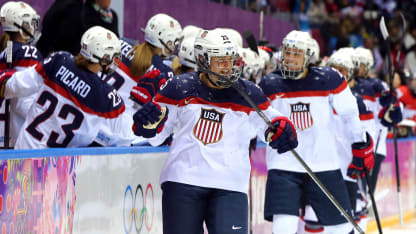
By
Devin Lowe / Wild.com
Darwitz grew up in a world where skating alongside the boys was sometimes the only option, save for not skating at all. In her first year of international competition, when she was 15, women's hockey was introduced to the Olympic program for the first time. In that inaugural year, the United States took home the first gold medal awarded for reaching the new pinnacle of women's hockey.
Since then, USA Hockey and its regional affiliates have taken exceptional strides in getting girls involved in what has historically been a male-dominated sport.
Kristen Wright, manager of girls player development for USA Hockey, credits the 1998 Olympics in Nagano, Japan for inspiring the next generation of girls to play hockey. But even in hockey-crazed Minnesota, the youth structure wasn't ready to support an influx of girls' teams overnight. That took work.
"I grew up in Minnesota where they play a lot of hockey and I got to play on a girls team, but then I also moved to Arizona where girls hockey was not as popular as it is now," Wright said.
To grow both the boys and girls game on a national level, USA Hockey began using Try Hockey for Free and similar events to draw kids to the sport in a way that freed lower income families from the financial burdens of what remains by and large the most expensive youth sport.
By placing these kinds of events in warmer climes where a backyard rink simply isn't an option, both boys and girls have the opportunity to discover hockey. Wright says that USA Hockey is seeing exceptional growth in California, particularly for girls.
So, in the same year that Scottsdale, Arizona native Auston Matthews was selected first overall in the NHL Draft, Corona, California native Cayla Barnes earned her spot on the U.S. women's national team at just 17 years old.
A standout example, no doubt, but how about the numbers?
Over the past 10 seasons, USA Hockey has recorded 36 percent growth in the number of girls and women involved in hockey, from competition to coaching to officiating. And at the collegiate level, about 150 women's hockey programs compete across the country, giving girls the opportunity to play beyond high school or their 19-U club team.
Events like Try Hockey for Free, coupled with USA Hockey's own Girls Hockey Weekend in October and the International Ice Hockey Federation's Global Girls' Game in the spring, have put girls' hockey on the map like never before.
But even though growth has been tremendous, there's still much work to do, work that Wright and others are eager to undertake.
"We were really excited to try to break the 70,000 mark. We were at 69,000 last year, and I think we can get there," Wright said of USA Hockey's girls participation numbers. "But for me, I want to see that 100,000 mark. It'd be very exciting to break the 100,000 mark of females participating in USA Hockey across the board."
While Wright monitors youth growth, Laura Halldorson has her eyes on what women can do to stay involved in hockey after they finish their college careers.
Halldorson, who was instrumental in turning the Minnesota Golden Gophers women's hockey program into a national powerhouse as its head coach for 11 years, works with the Minnesota Whitecaps to try to secure the best season schedule she can for the team.
Though the Whitecaps are a professional women's team much like those competing in the National Women's Hockey League out east, they still have no league to call home. Their schedule has traditionally been pieced together with matchups against Division I women's programs, Canadian teams and the new NWHL clubs.
"We really do have a great group of women," Halldorson said. "Many are coaches and they have a sense of the importance of giving back and really inspiring the next generation of women's players."
The Whitecaps have few revenue streams and rely on the support of fundraisers. The proceeds from program sales and the Split the Pot Raffle from the Wild's Girls Hockey Weekend game against the Arizona Coyotes will benefit the Whitecaps, who, despite their financial situation, regularly defeat top-notch college programs.
Their goal is to find a home in a league that can offer some stability -- and, potentially, some compensation for its players like in the NWHL.
"Obviously there's still more we need to accomplish. [We need to] find ways to financially support our sport. But when I look at the college level and the national team level, it's amazing how many great teams we have now and the parity that you see."
Even though girls' and women's hockey is not without its own unique challenges, it's hard not to look back at how far the game has come since Natalie Darwitz, Kristen Wright, Laura Halldorson and others were kids. For these women, Girls Hockey Weekend offered time for both reflection on the past and a celebration for all that's yet to come.
"I think [Girls Hockey Weekend] will help raise awareness and give opportunity," Darwitz said. "Hopefully it inspires little girls to pick up a stick and lace up the skates and want to play hockey. It's such a great sport. I've had tremendous opportunities and experiences and created lieflong friends through hockey, and I want to share that with as many people as possible and try to get them involved in the game.
"At the end of the day, why did we play the game? Because it was fun. It is fun."



